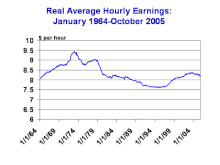Wage: Difference between revisions
Removing Today's articles for improvement tag (bot - disable) |
Martingerv (talk | contribs) m added a source for wage lookup. |
||
| Line 16: | Line 16: | ||
[[Image:US Real Wages 1964-2004.gif|thumb|Historical graph of [[real wages]] in the US from 1964 to 2005.]] |
[[Image:US Real Wages 1964-2004.gif|thumb|Historical graph of [[real wages]] in the US from 1964 to 2005.]] |
||
In the [[United States]], wages for most workers are set by [[Supply and demand|market forces]], or else by [[collective bargaining]], where a [[labor union]] negotiates on the workers' behalf. The [[Fair Labor Standards Act]] establishes a minimum wage at the federal level that all states must abide by, among other provisions. Fourteen states and a number of cities have set their own [[minimum wage]] rates that are higher than the federal level. For certain federal or state government contacts, employers must pay the so-called [[prevailing wage]] as determined according to the [[Davis-Bacon Act]] or its state equivalent. Activists have undertaken to promote the idea of a [[Living wage|living wage rate]] which account for living expenses and other basic necessities, setting the living wage rate much higher than current [[minimum wage law]]s require. |
In the [[United States]], wages for most workers are set by [[Supply and demand|market forces]], or else by [[collective bargaining]], where a [[labor union]] negotiates on the workers' behalf. The [[Fair Labor Standards Act]] establishes a minimum wage at the federal level that all states must abide by, among other provisions. Fourteen states and a number of cities have set their own [[minimum wage]] rates that are higher than the federal level. For certain federal or state government contacts, employers must pay the so-called [[prevailing wage]] as determined according to the [[Davis-Bacon Act]] or its state equivalent. Activists have undertaken to promote the idea of a [[Living wage|living wage rate]] which account for living expenses and other basic necessities, setting the living wage rate much higher than current [[minimum wage law]]s require. Newer websites, like http://www.thesalarypeople.com, do promote transparency in wage setting by displaying the actual wages paid by firms, city or jobtitle, in hour rates or yearly rates. |
||
== See also == |
== See also == |
||
| Line 42: | Line 42: | ||
==External links== |
==External links== |
||
{{Wiktionary|wage}} |
{{Wiktionary|wage}} |
||
* http://www.thesalarypeople.com - wage database populated by US Department of Labor data. |
|||
* [http://www.bls.gov/bls/blswage.htm U.S. Bureau of Labor Statistics] |
* [http://www.bls.gov/bls/blswage.htm U.S. Bureau of Labor Statistics] |
||
* [http://www.bibliomania.com/2/1/65/112/frameset.html Wealth of Nations] - click Chapter 8 |
* [http://www.bibliomania.com/2/1/65/112/frameset.html Wealth of Nations] - click Chapter 8 |
||
Revision as of 02:28, 15 July 2013
This article needs additional citations for verification. (October 2009) |
A wage is remuneration paid by an employer to an employee. It may be calculated as a fixed task based amount, or at an hourly rate, or based on an easily measured quantity of work done. It is contrasted with salaried work, which is based on a fixed time period and with commission which is based on performance.
Determinants of wage rates
Depending on the structure and traditions of different economies around the world, wage rates will be influenced by market forces (supply and demand), legislation, and tradition. Market forces are perhaps more dominant in the United States, while tradition, social structure and seniority, perhaps play a greater role in Japan.[1]
Wage Discrimination
Even in countries where market forces primarily set wage rates, studies show that there are still differences in remuneration for work based on sex and race. For example, according to the U.S. Bureau of Labor Statistics, in 2007 women of all races made approximately 80% of the median wage of their male counterparts. Similarly, white men made about 84% the wage of Asian men, and black men 64%.[2] These are overall averages and are not adjusted for the type, amount, and quality of work done.
Wages in the United States

In the United States, wages for most workers are set by market forces, or else by collective bargaining, where a labor union negotiates on the workers' behalf. The Fair Labor Standards Act establishes a minimum wage at the federal level that all states must abide by, among other provisions. Fourteen states and a number of cities have set their own minimum wage rates that are higher than the federal level. For certain federal or state government contacts, employers must pay the so-called prevailing wage as determined according to the Davis-Bacon Act or its state equivalent. Activists have undertaken to promote the idea of a living wage rate which account for living expenses and other basic necessities, setting the living wage rate much higher than current minimum wage laws require. Newer websites, like http://www.thesalarypeople.com, do promote transparency in wage setting by displaying the actual wages paid by firms, city or jobtitle, in hour rates or yearly rates.
See also
- Compensation of employees
- Employee benefit (non-monetary compensation in exchange for labor)
- Employment
- Labour in Economics
- List of countries by average wage
- Performance-related pay
- Wage labour
- Wage share
- Real wage
- Minimum wage
- List of sovereign states in Europe by net average wage
Political science:
References
- ^ [1] - Education 2020 Homeschool console, Vocabulary Assignment, definition entry for "wage rate" (may require login to view)
- ^ U.S. Bureau of Labor Statistics. "Earnings of Women and Men by Race and Ethnicity, 2007" Accessed June 29, 2012
External links
- http://www.thesalarypeople.com - wage database populated by US Department of Labor data.
- U.S. Bureau of Labor Statistics
- Wealth of Nations - click Chapter 8
- Understanding Capitalism Part III: Wages and Labor Markets - Critical of capitalism
- U.S. Department of Labor: Minimum Wage Laws - Different laws by State
- Average U.S. farm and non-farm wage
- LaborFair Resources - Link to Fair Labor Practices
- The Truth Behind Wages in Mining - Link to An Article Abouth How Wages are measured and Current Standards for Mining Professionals
- Database Central Europe - Data on average wages in Central Europe and in Emerging Markets

